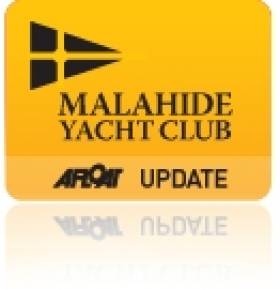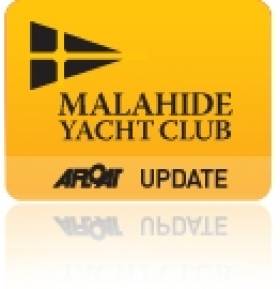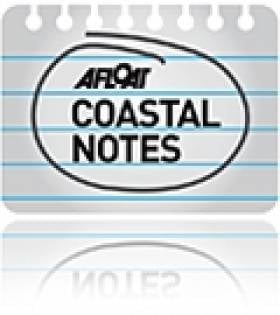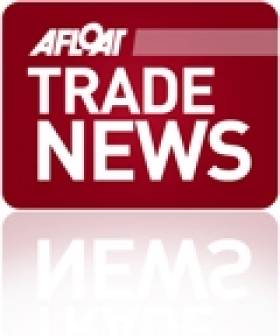Displaying items by tag: Malahide
Successful Early Bird Regatta at Malahide
Following on from its hosting of the 420 Class Leinster Championships the previous weekend, Malahide Yacht Club’s newly re-developed Dinghy Sailing Centre at the Broadmeadows was the scene for a highly successful Early Bird Regatta (Saturday 31st March) which attracted 60 boats in four classes from Dun Laoghaire, Howth, Sutton, Rush, Skerries and Malahide.
The event, supported by Dinghy Supplies, Starbucks and Dunnes Stores, had three races for each class, sailed in moderate northerly winds on Olympic courses set by Race Officer Neil Murphy. The outstanding performance on the days was Howth’s Ronan Cull who topped the Laser class with three wins to finish 1st overall ahead of Daragh Peelo (MYC) and Daragh Sheridan (HYC).
The Laser Radial division was dominated by MYC sailors, with Derek Sheehan, Ciaran Costello and Darren Griffin heading the rankings while Stephen Craig of the Royal St.George YC won the Laser 4.7s.
His younger brother Harry headed the senior Optimist fleet ahead of Skerries’ Ben Walsh and Conor Kneafsey (National YC) while another NYC sailor Peter Fagan topped the junior fleet ahead of Malahide’s Gemma McDowell and Nicola Ferguson (NYC).
Philip McDowell (with crew Cian Buckley) of the host club won the 420 Class and the Topaz honours went to Malahide’s Conor Costello from clubmates Diarmuid Marron and Peter Cunning.
Malahide Yacht Club’s next open event on the Broadmeadows is the Topaz National Championships in late June while in April, introductory sailing courses will be provided for the three local primary schools and an Open Day for those interested in joining the club will be held on Saturday 21st April.
This Friday Last Day for 2012 Fingal Lifeguard Applicants
#WATER SAFETY - This coming Friday 30 March is the closing date for applications for Fingal County Council beach lifeguards for the 2012 summer season.
Lifeguard cover will be provided on Fingal beaches on weekdays and weekends 11am to 7pm from 2 July till the last week of August, depending on weather and staff levels.
Beaches and bathing places scheduled to be guarded this summer include Balbriggan (front beach), Skerries South, Loughskinny, Rush North and South Shores, Portrane (Tower Bay and The Brook), Donabate, Malahide, Portmarnock, Sutton (Burrow Road) and Howth (Claremount).
Applicants must be not less than 17 years of age on 1 May 2012. Application forms are available to download HERE.
Malahide Yacht Club Opens Redeveloped Dinghy Centre
#SAILING CLUB – Malahide Yacht Club has unveiled its newly re-developed Dinghy Sailing Centre at the Broadmeadows to herald a new era in the Club’s dinghy racing and sail training activities, a move that coincides with a new membership drive.
Club members attending the Official Opening celebration on Sunday 11th March were addressed by the Mayor of Fingal, Cllr. Gerry McGuire, the President of the Irish Sailing Association Niamh McCutcheon and the Club’s 1980 Olympic Silver Medallist David Wilkins (who travelled from the UK specially for the occasion). Other speakers included Club Commodore Bob Sugrue and his predecessor Martin Clancy who spearheaded the development.
The distinctive split-level ultra-modern facility on the Sea Road, built at a cost of €450,000, features a general purpose area/classroom, changing rooms and showers on the ground floor, while on the new first-floor level, there is a large lounge/viewing area, a committee room and storage room.
The project, which took 6 months to complete, was funded by Club savings, a bank loan and ongoing members’ fund-raising initiatives, and without any grants, lottery funding etc. Considerable savings on costs were achieved through a significant level of voluntary effort by many members who gave of their time and professional expertise to see the project through to completion.
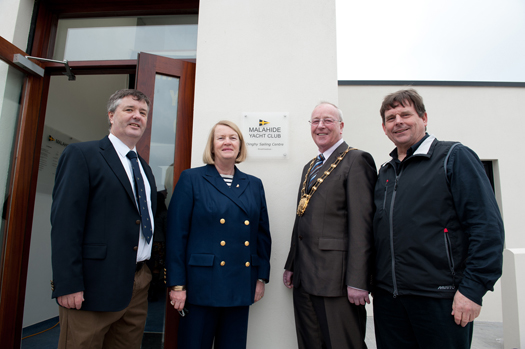
MYC Commodore Bob Sugrue, ISA President Niamh McCutcheon, Mayor of Fingal Cllr. Gerry McGuire and 1980 Olympic Silver Medallist David Wilkins
The Club, founded in 1958, was at the forefront of dinghy sailing development in Ireland in the ‘60s and ‘70s, and has produced six Olympians (sailing in nine of the last 10 Olympic Games) and 28 national championship winners in its 54-year history. MYC’s David Burrows has qualified to compete in his fourth Games this summer in the Star Class while Scott Flanigan, crewing in the 470 Class, still has the opportunity to qualify.
Growing numbers of Laser, Optimist, Topaz and 420 Class dinghies in recent years underlined the need to replace the previous old and outdated structure at the Broadmeadows, widely acknowledged as one of the finest stretches of water in Ireland on which to learn to sail. The Club is actively seeking new members and now has the facilities which can attract both new and experienced sailors to the Broadmeadows.
According to Club Commodore Bob Sugrue, the new facility means the Club is now geared to run regional and national events on the Broadmeadows. “We have already been invited to host a number of events this season, starting with the 420 Class Leinster Championships on March 24/25, the Topaz National Championships in June and the Optimist Western Championships in September which is expected to attract over 100 entries”.
The Club is unusual in sailing terms in that it is the only sailing club with two separate clubhouses – one on the original site at St. James’s Terrace in the village and the other at Broadmeadows – and two separate sailing areas – the tidal Lower Estuary for keelboat racing and cruising and the non-tidal Upper Estuary for dinghies.
Largest State Energy Infrastructure Project Since Ardnacrusha Now Close To Completion
The largest state energy infrastructure project, connecting the Irish electricity grid and Great Britain advanced significantly today as work began to lay cables under the sea bed of the Irish Sea. The €600m East West Interconnector project is being developed by EirGrid – the independent electricity transmission system operator in the Republic of Ireland.
The Interconnector is essential strategic economic infrastructure linking Ireland to the much larger energy markets of Britain and Europe.
It involves the laying of 180 kilometres of undersea and approximately 80 kilometres of underground cables to enable the flow of electricity in both directions between Ireland and Great Britain. This means that when Ireland needs extra electricity it can import it but crucially, it opens a new export market for Ireland's abundant renewable energy.
With most of the underground cables now laid, the cable-laying ship the Nostag 10 anchored itself at North Beach, Rush Co. Dublin to lay the marine cables of the €600 million project partly funded by the European Union. This unusual vessel, off the North Dublin coast, is already attracting curious onlookers.
Yesterday the ESRI issued a report which confirmed that the creation of a single EU-wide electricity market offers significant benefits for Ireland. The report, entitled the Internal EU Electricity Market: Implications for Ireland concluded that 'the single EU electricity market should result in lower electricity prices and increased competition as suppliers from Great Britain and beyond will be able to enter the Irish market. This should spur efficiency and increase consumer choice.'
As the cable laying got underway, Minister for Communications, Energy and Natural Resources, Pat Rabbitte TD was present to observe this key milestone for the project with just one year to completion when trading will commence on this interconnector.
Commenting on the project, Minister Rabbitte said, "The interconnector will improve security of supply, as well as increasing competition and assisting in achieving our ambitious renewable targets. I am delighted that EirGrid are on track to complete the project within budget and on time, by the end of next year.
"Witnessing the laying of the marine cable across the Irish Sea is symbolic of linking Ireland, a geographically isolated Island, to the single European energy market which will ultimately benefit all electricity consumers and generators."
As the Nostag 10 makes its way across the sea, the cable will be carefully lowered into the water and laid in a narrow trench which will be opened and closed by a remote controlled vehicle operating on the sea bed. The cable laying work is expected to take approximately eight months to complete.
Andrew Cooke, EirGrid's Director of Grid Development, said "This is a very exciting stage in the project and probably one of the most challenging. Before work started, EirGrid carried out a detailed marine survey to identify a route for the undersea cable that would have the least impact on marine life.
"With over 600 people currently working on the project, it is great to see the interconnector cable finally beginning to be laid at sea. Europe's electricity future will be reliant on interconnector projects of this nature and currently EirGrid is investigating the feasibility of further interconnection to Europe."
The Interconnector is scheduled to be operational in late 2012 and will be capable of carrying power to supply the equivalent of 300,000 homes.
Wexford Club Honoured in Coastcare Merit Awards
Wexford Sub Aqua Club has been recognised for its commitment to the environment in an awards ceremony in Dublin last week.
The Wexford People reports that Minister of State Fergus O'Dowd presented the club with An Taisce's Coastguard Initiative of the Year Award for its work in cleaning up the beaches and waters around Kilmore Quay.
The club was one of many organisations and volunteers throughout Ireland recognised by An Taisce's Coastcare Merit Awards.
Among them were the Portmarnock Community Coastcare Group and Malahide resident Philip Lynch, who was rewarded for his efforts in protecting the north Dublin town's coastline.
Healthy Discounts Give Irish Boat Sales a Lift
Any upturn couldn't come quick enough though. The Irish Marine Federation (IMF) is counting the cost of recession that has reduced its membership by up to two thirds as marine firms closed their doors.
"For the first time in three years I'm seeing fresh enquires and importantly new blood coming into Irish boating, said Bernard Gallagher of BJ Marine in Malahide, north Dublin.

Boat dealers are offering substantial discounts
The new confidence in Irish boat buyers is primarily being seen in the sailing boat market.
One of the most accurate barometers of marine leisure activity, some dealers are reporting a return business levels not seen for three or four years.
"We've just sold a lovely 38-footer in to Howth and we've more sales in the pipeline said" Gallagher.
Other dealers confirm the same saying there is definitely a positive mood among buyers to go the extra step in the sales process.
It's quite a turnaround because up until very recently, dealers admit there was 'no boat buying mood at all'.
Ironically though after such poor sales at home there's now a real shortage of boats for sale here because over the past few years a lot of Irish boat stock was sold abroad.
"We badly need boats for our brokerage listings", says Gallagher who also operates branches in Belfast and Malta.
Many say sales will never get back to the dizzy heights of 2006 but for now good product ranges at the right place plus a splash of Easter sunshine is helping to move things at least a step in the right direction.
Irish dealers have been resourceful in finding markets abroad and an example of this is Dun Laoghaire dealer MGM boats who has just returned from the Portuguese boat show where there was positive vibes in Villamoura despite the recent bailout there too!
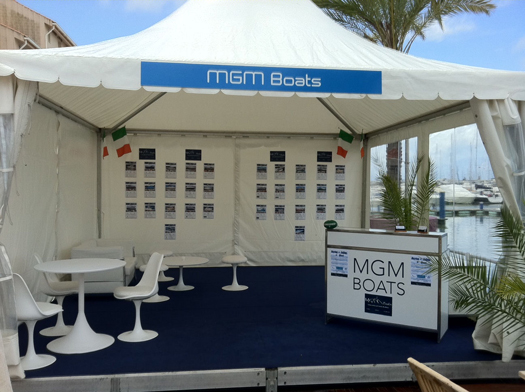
The MGM Boats Stand at the recent Villamoura Show
Marina Manager Course Held in Dublin
As part of the course the group developed a marina scheme for Clontarf Yacht and Boat Club.
By basing the course in Ireland delegates were able to experience at first hand Irish facilities, some for the first time. Sarah Dhandar, Director of Training at the BMF expressed her delight at the venue, "superb facilities, conveniently close by".
Coastal Harbours Benefit from Infrastructure Funding
Malahide is one of over a dozen harbours around the coast to benefit from an announcement by Sean Connick TD, Minister of State at the Department of Agriculture, Fisheries and Food today that funding has been approved for harbour development projects in Local Authority owned harbours under the Fishery Harbour and Coastal Infrastructure Development Programme 2010.
Funding has been approved for projects that have been identified as priorities by each of the five Local Authorities listed below. Up to 75% of the cost of an approved project (subject to the maximum figure approved) will be available for each project with the Local Authority providing the balance. The project must be completed and funding drawn down before the end of the current calendar year. The projects are located in harbours around our coastline that are in Local Authority ownership.
Minister Connick said “The Local Authority owned fishing harbours supplement and underpin the activities undertaken in our Department of Agriculture, Fisheries and Food owned Fishery Harbour Centres. These harbours are of great importance to the fishing and aquaculture industries and provide much needed employment and support for economic activity in our coastal communities. I am delighted to be able to announce the provision of this funding to enhance and develop these facilities”.
The following is a list of the Local Authorities that have been approved funding:
|
Local Authority |
Approved Funding |
||
|
FINGAL COUNTY COUNCIL |
|||
|
Malahide - Repair to slipway |
€55,875 |
||
|
SLIGO COUNTY COUNCIL |
|||
|
Mullaghmore Harbour - Dredging of harbour |
€90,000 |
||
|
CORK COUNTY COUNCIL |
|||
|
Ballycotton - Breakwater Emergency works |
€225,000 |
||
|
WEXFORD COUNTY COUNCIL |
|||
|
Fethard harbour 1 - Fishing harbour and slipway study |
€18,750 |
||
|
Fethard Harbour 2 - Fishing harbour and slipway |
€7,500 |
||
|
Kilmore Quay Harbour - Provide a new laydown area at the end of West Pier |
€54,750 |
||
|
Courtown Harbour 1 - Health & Safety improvements |
€18,750 |
||
|
Duncannon & Hook Peninsula Piers - New CCTV system & Harbour Repairs |
€56,250 |
||
|
WEST CORK COUNTY COUNCIL |
|||
|
Castletownbere - Bank Harbour |
€18,422 |
||
|
Bantry- Doneen Pier |
€23,288 |
||
|
Schull - Lahertanavally Pier |
€24,375 |
||
|
Schull - Ballycummisk Pier |
€19,916 |
||
|
Castletownbere - Trafrask Pier |
€18,422 |
||
|
Western Division - Safety Works |
€46,369 |
||
|
Bantry Pier - Public Toilets |
€30,000 |
||
|
|
|
|
|
|
|
|
Total Estimated Cost |
€707,667 |
Swords Sailing and Boating Club
Swords Sailing & Boating Club
 Located Halfway between Malahide and Swords, near the main Belfast road. Season runs from March to December. Very active dinghy programme – and a very active club for both the young and the young at heart!
Located Halfway between Malahide and Swords, near the main Belfast road. Season runs from March to December. Very active dinghy programme – and a very active club for both the young and the young at heart!
We have grown from humble beginnings, operating from a cargo container, to become a well established club boasting four national champions in different fleets in the one year!!
Racing every Sunday at 2pm and Wednesdays at 7.30. Friendly family Orientated club. New members always welcome.
Swords Sailing & Boating Club, c/o Donal Brennan, Broadmeadow Estuary, Swords, Co Dublin. Tel: 01 8454 686, email: [email protected]
Have we got your club details? Click here to get involved



























